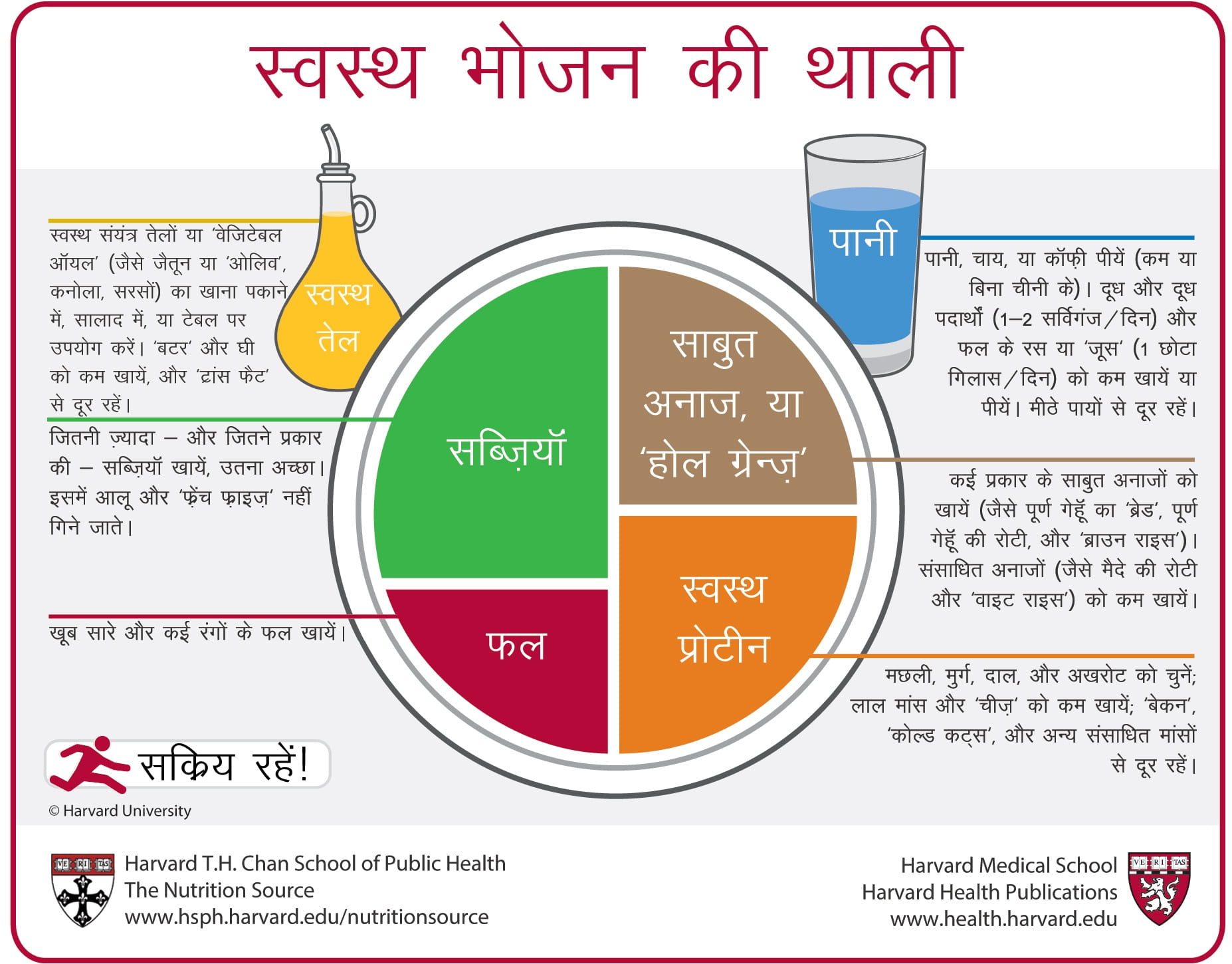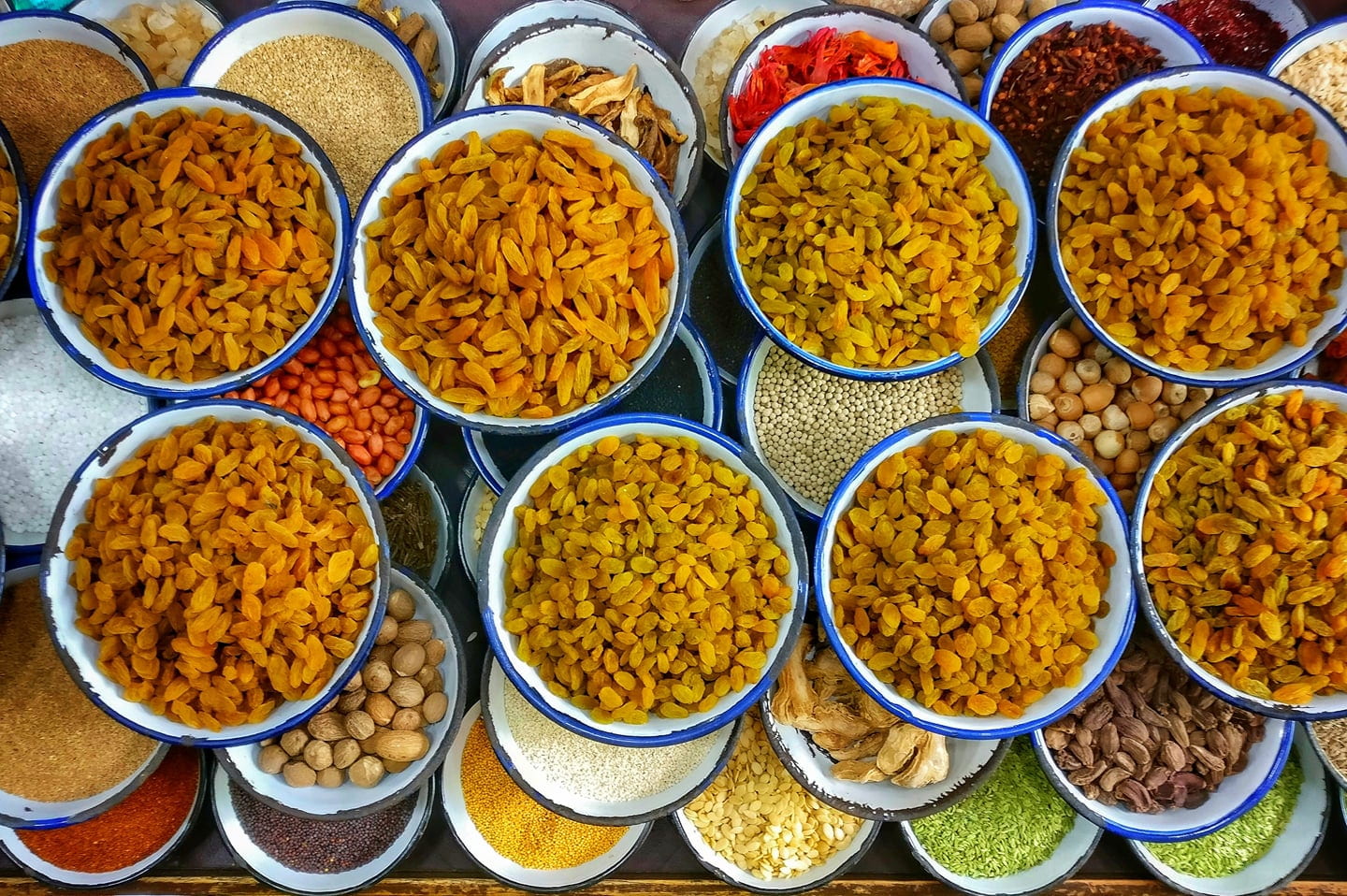Learning Episodes:
1. Students brainstorm about healthy foods and eating habits. They design an infographic.
2. Students examine another infographic, identify what is missing in theirs and make changes.
3. Students read and highlight the information they did not include based on the reading (retrieved from here). They highlight all the subjunctives. They choose at least 10 phrases they consider useful for the topic.
- फल और सबज़ियों को अपने भोजन का सबसे बड़ा हिस्सा बनायें – आधी थाली मात्राः
कोशिश करें कि अनेक रंगों और कई प्रकार के फल और सब्ज़ियां खायें। और याद रखें कि स्वस्थ भोजन की थाली में आलू को सब्ज़ी नहीं माना जाता है, क्योंकि आलू को खाने से रक्त शर्करा, या ‘ब्लड ग्लूकोज़’ पर नकारात्मक असर होता है।
- ‘होल ग्रेन्ज़’, या साबुत अनाजों को ज़्यादातर खायें – एक चैथाई थाली मात्राः
साबुत और पूर्ण अनाजों – पूर्ण गेहूॅं, जौ, बाजरा, जुवार, जै, ‘ब्राउन राइस’ या असंसाधित चावल, और इनसे बनाये गए खाद्य पदार्थ, जैसे कि पूर्ण गेहूॅं से बनाई गई रोटी – का मैदे से बनाई गई रोटी, ‘वाइट राइस’, और अन्य संसाधित अनाजों से रक्त शर्करा और इंसुलिन पर कम असर होता है।
- प्रोटीन की शक्ति – एक चैथाई थाली मात्राः
मछली, मुर्ग, दाल, और अखरोट स्वस्थ और बहुमुखी प्रोटीन के स्रोत हैं – इनको सालाद में डाला जा सकता है, और यह सब्ज़ियों के साथ अच्छा जाते है। लाल मांस को कम खाना चाहिए, और संसाधित मांस, जैसे कि ‘बेकन’ और ‘साॅसेज’ से दूर रहना चाहिए।
- स्वस्थ संयंत्र तेल या ‘वेजिटेबल आॅयल’ – मध्यम मात्रा मेंः
स्वस्थ वेजिटेबल आॅयल, जैसे जैतून या ‘ओलिव’, कनोला, सोयाबीन, सनफ़लावर, मूंगफली, सरसों, इत्यादी के तेलों को चुनें, और ‘पार्शली हाइड्रोजनेटिड’ तेलों से दूर रहें, क्योंकि इनमें अस्वस्थ ‘ट्रांस फैट’ होते हैं। याद रखें, कि केवल कम या शून्य फैट होने से खाद्य पदार्थ ‘‘स्वस्थ’’ नहीं हो जाते।
- पानी, चाय, या काॅफ़ी पीयेंः
मीठे पायों से दूर रहें, दूध और दूध से बने अन्य खाद्य पदार्थों के दिन में केवल एक या दो सर्विगंज़ खायें, और दिन में ज़्यादा से ज़्यादा एक छोटा गिलास फल का रस पियें।
- सक्रिय रहेंः
स्वस्थ भोजन की थाली के प्लेसमैट पर वह लाल रंग की भागती हुइ आक्रिति आपको याद दिलाने के लिए है, कि सक्रिय रहना भी वज़न संतुलन के लिए आवश्यक है।
स्वस्थ भोजन की थाली का मुख्य सन्देश ‘‘डायटेरी क्वालेटी’’, या आहार की गुणवत्ता के बारे में है।
- कार्बोहाइड्रेट की मात्रा पर ध्यान देने से ज़्यादा यह सोचना ज़रूरी है कि हम अपने आहार में किस प्रकार के कार्बोहाइड्रेट खाते हैं, क्योंकि कार्बोहाइड्रेट के कुछ स्रोत – जैसे सबज़ियाॅं (आलू के अलावा), फल, साबुत अनाज, और दाल – अन्य स्रोतों से ज़्यादा स्वस्थ हैं।
- स्वस्थ भोजन की थाली लोगों को मीठे पायों से दूर रहने के लिए भी बताती है, जो उष, या ‘‘कैलोरीज़’’ से भरे हैं – और आमतौर पर इनमें पोषण कम होता है।
- स्वस्थ भोजन की थाली लोगों को स्वस्थ ‘‘वेजिटेबल आॅयल’’ खाने को प्रोतसाहित करती है, और इसमें स्वस्थ स्रोतों से मिले गए ‘‘फ़ैट्स’’ के उपभोग पर कोई उपरी सीमा नहीं है।
4. Teacher brings attention to the language structures — infinitives in a subject function सक्रिय रहना आवश्यक है and with postposition with adverbial function … होने से and participles – present active भागती हुइ आक्रिति, and perfect passive उबले हुए अंडे, बनाई गई रोटी – provides a few examples from recipes (2 या 3 बारीक कटी हुयी हरी मिर्च, भुना जीरा, साबुत गरम मसाले- 7 काली मिर्च और 2 लौंग — दरदरे कटे हुए, etc.) Note: Teacher may choose to further illustrate the use of the present participle and play भीगती आँखों से (डूबती रातों में, टूटती साँसों को)
5. Students, based on their ideas for healthy foods, choose one gali and make changes with a healthy twist to attract more customers — हमारा खाना स्वास्थ्य के लिए अच्छा है. (Instructions — Imagine you are a dietician and are hired by the businesses in one gali to help with their marketing. Make at least 15 suggestions and explain the reason for each. Non-negotiables: use at least 15 subjunctives, 10 phrases you highlighted, at least 5 infinitives and 5 participles).
6. When done, more advanced students read क्यों ना जान बचाने वाला खाना सस्ता हो and discuss at least 5 suggestions for India.
